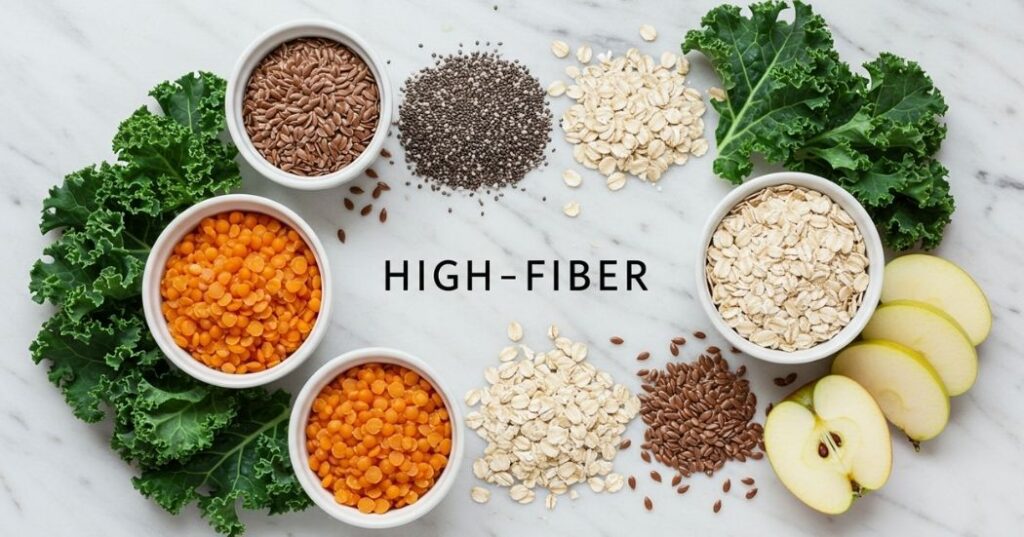How to Keep Your Blood Sugar Steady—Naturally and Effectively
Feeling inexplicably drained after meals? Struggling with sudden mood dips, irritability, or persistent sugar cravings that seem to strike out of nowhere? These often-overlooked symptoms may be clear signs that your blood sugar levels are swinging more dramatically than they should, leading to energy crashes and hindering overall well-being. The truly good news? You possess the power to effectively stabilize your blood sugar levels naturally—by incorporating small, sustainable, and science-backed choices into your daily routine.
Let’s walk through a comprehensive guide to finding your sweet balance, using natural, evidence-based strategies to optimize your metabolic health.
🌾 Eat Smart: Prioritize Fiber for a Smoother Ride

Dietary fiber is not merely for digestive regularity; it is a critical player in blood sugar management. Fiber, particularly soluble fiber, forms a gel-like substance in your digestive tract, which significantly slows down the absorption of glucose (sugar) into your bloodstream. The remarkable result? A significantly less dramatic glucose rollercoaster, preventing sharp spikes followed by sudden crashes. This leads to more stable energy, fewer cravings, and improved overall metabolic health.
Strategically add these fiber powerhouses to your plate daily:
- Legumes: Incorporate a variety of lentils, chickpeas, and beans (black beans, kidney beans, navy beans). These are packed with soluble and insoluble fiber, as well as plant-based protein, offering a powerful combination for satiety and blood sugar control.
- Oats: Especially rolled oats or steel-cut oats, contain beta-glucan, a type of soluble fiber known for its remarkable ability to slow glucose absorption and improve insulin sensitivity.
- Chia Seeds and Ground Flax Seeds: These tiny titans are loaded with soluble fiber and healthy omega-3 fatty acids. When mixed with liquid, they form a gel that further enhances their blood sugar-stabilizing effects.
- Leafy Greens and Cruciferous Vegetables: Think spinach, kale, collard greens, broccoli, and cauliflower. These non-starchy vegetables are rich in fiber, vitamins, and minerals, providing volume and nutrients without significantly impacting blood sugar.
- Berries and Apples (with the peel!): Berries (blueberries, raspberries, strawberries) are high in fiber and antioxidants, with a relatively low glycemic index. Apples, especially with their skin intact, are excellent sources of pectin, a soluble fiber that aids blood sugar management.
The seminal Nurses’ Health Study, conducted by Harvard, provided compelling long-term data: Women with consistently higher fiber intake were observed to be 34% less likely to develop type 2 diabetes, powerfully underscoring fiber’s protective role in metabolic health. This makes fiber a foundational pillar in any strategy for natural ways to stabilize blood sugar.
🥑 Pair Carbs with Healthy Fats or Protein (Your Blood Sugar Buffer Combo)
It’s time to reframe your relationship with carbohydrates. The key to healthy carb consumption, especially for blood sugar stability, lies not in fearing them, but in pairing them intelligently. Healthy fats and proteins are your carbohydrates’ best friends. When consumed together, they significantly slow down the digestive process and the rate at which glucose enters your bloodstream, effectively curbing sugar spikes and promoting sustained energy.
Master these power pairings to transform your meals and snacks:
- Apple + Almond Butter: The fiber from the apple combines beautifully with the healthy fats and protein from almond butter, creating a satisfying and blood sugar-friendly snack.
- Whole Grain Toast + Avocado: Instead of plain toast, add creamy avocado for healthy monounsaturated fats and fiber. A sprinkle of Everything Bagel seasoning can add flavor without extra sugar.
- Brown Rice + Grilled Tofu/Chicken: When enjoying complex carbohydrates like brown rice, always ensure you have a substantial source of protein (like grilled tofu, chicken breast, or fish) alongside it. This slows the release of glucose.
- Quinoa Salad + Olive Oil Vinaigrette: Quinoa is a complete protein and complex carb. Drizzling it with an olive oil-based vinaigrette adds healthy fats that moderate its glycemic impact.
- Snack Rule of Thumb: When reaching for a snack, always aim for options that include at least one component of protein or healthy fat—not just standalone carbohydrates. This simple rule is a profound blood sugar game changer. For instance, instead of just a banana, have a banana with a spoonful of nut butter.
🚶♀️ Move Often: Even 10 Minutes Can Transform Your Blood Sugar
You absolutely do not need a restrictive gym membership or an intense workout routine to stabilize your blood sugar. Simple, consistent movement, particularly right after meals, can do wonders for your metabolic health. Physical activity helps your muscles take up glucose from the bloodstream for energy, thereby lowering blood sugar levels.
Integrate these easy movement strategies into your daily life:
- The Post-Meal Walk: Aim for a brisk 10-15 minute walk after lunch or dinner. Even a gentle stroll can significantly impact post-meal glucose spikes.
- Active Breaks: Incorporate stretching while watching TV, or stand up and do some desk squats or lunges between long Zoom calls or work sessions.
- Walk More, Sit Less: Take the stairs instead of the elevator, park further away, or walk during phone calls. Every bit of movement counts.
Compelling research published in the Diabetologia Journal in 2022 highlighted this effect, finding that post-meal walks can lower blood sugar by up to 30% compared to prolonged sitting. This makes movement one of the most accessible natural ways to stabilize blood sugar.
😴 Reset with Better Sleep: More Powerful Than You Think for Glucose Control
In our fast-paced world, sleep is often the first thing to be sacrificed. However, chronic sleep deprivation is a potent disruptor of blood sugar regulation and insulin sensitivity. Even a single night of poor sleep can increase insulin resistance, making your body less effective at using insulin to manage glucose. Over time, this can significantly elevate your risk for type 2 diabetes.
Prioritize these sleep stabilizers to protect your metabolism:
- Magnesium-Rich Foods: Incorporate foods like pumpkin seeds, spinach, almonds, and avocados into your diet. Magnesium is a crucial mineral involved in glucose metabolism and insulin signaling.
- Implement a Power-Down Hour: Create a sacred hour before bed where you completely avoid blue light-emitting screens (phones, tablets, laptops, TVs). Blue light suppresses melatonin, the sleep hormone, and can keep your brain artificially alert.
- Stick to a Consistent Sleep-Wake Schedule: Go to bed and wake up at roughly the same time every day, even on weekends. This consistent rhythm helps regulate your body’s circadian clock, which in turn influences hormone release and metabolic processes.
- Create a Conducive Sleep Environment: Ensure your bedroom is cool, dark, and quiet.
Research consistently shows the profound link: Women who regularly sleep less than 6 hours are at a 2x higher risk of developing glucose intolerance, highlighting sleep as a critical component in natural ways to stabilize blood sugar.
🧘♀️ Stress Less, Balance More: The Cortisol-Blood Sugar Connection

In our modern lives, chronic stress is pervasive, and its impact on blood sugar levels is direct and significant. When you’re stressed, your body releases stress hormones like cortisol. Cortisol’s primary role is to raise blood sugar to provide immediate energy for a “fight or flight” response. While vital in acute situations, chronically elevated cortisol keeps blood sugar persistently high, contributing to insulin resistance and metabolic dysfunction. Calming your mind is not just for mental well-being; it actively protects your metabolism.
Integrate these simple balance rituals into your day:
- Mindful Breathing: Practice short, focused breathing exercises. A 5-minute session with a guided breathing app (like Calm or Insight Timer) or techniques like 4-7-8 breathing can rapidly activate your parasympathetic nervous system, lowering cortisol.
- Journaling: Spend a few minutes each morning or evening jotting down your thoughts, particularly any stress triggers or worries. This “brain dump” can help externalize stressors and reduce their mental load.
- Herbal Teas: Sip on calming herbal teas like chamomile, lemon balm, or holy basil (Tulsi). These herbs have adaptogenic and anxiolytic properties that can help soothe the nervous system.
- Mindfulness & Meditation: Even short daily practices can reduce perceived stress and improve emotional regulation.
Studies have shown that consistent mindfulness practices can lead to measurable reductions in A1C levels (a marker of long-term blood sugar control) in prediabetic adults, underscoring the power of stress reduction as a natural way to stabilize blood sugar.
🧂 Rethink Sugar: Go Low-Glycemic, Not Deprived
The goal of blood sugar stabilization isn’t about complete deprivation or eliminating all forms of sugar forever. Instead, it’s about making smart, informed swaps and focusing on achieving better overall balance in your diet. This means understanding the glycemic index (GI) and choosing lower-GI alternatives that cause a slower, more gradual rise in blood sugar.
Embrace these simple, delicious switches:
- Flavor Boosters over Sugar: Instead of adding sugar to your coffee or oatmeal, use natural flavor enhancers like cinnamon, vanilla extract, or unsweetened cocoa powder.
- Hydration Heroes: Swap sugary sodas and fruit juices for sparkling water infused with fresh lime, lemon, cucumber, or berries.
- Smart Chocolate Choices: When a chocolate craving strikes, opt for dark chocolate with at least 70% cocoa content over milk chocolate. Dark chocolate is lower in sugar and higher in beneficial antioxidants.
- Whole-Food Baking Alternatives: When baking, experiment with natural sweeteners like dates (used sparingly) or mashed banana, and substitute refined white flour with almond flour, coconut flour, or whole-wheat flour for added fiber and a lower glycemic impact.
🚩 Quick Signs Your Blood Sugar May Be Out of Balance: Listen to Your Body
Your body often sends clear signals when your blood sugar isn’t stable. Learning to recognize these subtle cues can empower you to make timely dietary and lifestyle adjustments.
- Afternoon Crashes: Feeling inexplicably exhausted, sluggish, or needing a nap in the mid-afternoon, even after adequate sleep.
- Irritability When Hungry (Hanger): Experiencing disproportionate anger, frustration, or emotional sensitivity when you’re hungry, often before meals.
- Persistent Sugar Cravings After Meals: Feeling an intense desire for something sweet shortly after you’ve finished eating, indicating your meal may have triggered a blood sugar spike and subsequent crash.
- Brain Fog or Anxiety: Difficulty concentrating, feeling mentally cloudy, or experiencing unexplained anxiousness.
- Increased Thirst or Frequent Urination: While more severe, these can also be signs of elevated blood sugar.
If these symptoms sound familiar, it’s a gentle nudge from your body that it’s time to start actively stabilizing your blood sugar—gently, naturally, and sustainably.
📦 Build Your Lifestyle Stack: Blood Sugar Balance & Beyond
Stabilizing your blood sugar is a powerful first step—but lasting energy, metabolic resilience, and hormonal balance require a full-stack approach to wellness. Explore these science-backed resources to build your personalized anti-inflammatory lifestyle system:
- 😴 Sleep & Glucose Recovery
Poor sleep can spike cortisol and destabilize blood sugar overnight. Learn how to fuel deeper rest and support nighttime metabolism with strategic nutrition:
👉 Best Foods for Sleep Recovery and Muscle Repair - 🦠 Gut Reset for Metabolic Health
Your gut microbiome plays a crucial role in blood sugar regulation, insulin sensitivity, and energy balance. Start restoring your gut with this foundational nutrition guide:
👉 Beginner’s Guide to Gut Health Diet - 🔥 Calm Inflammation to Steady Glucose
Chronic inflammation disrupts insulin response. Discover how targeted foods can lower inflammation and help prevent sugar crashes throughout the day:
👉 Anti-Inflammatory Foods List for Everyday Wellness
✅ Take the first step to stable energy, fewer crashes, and vibrant health.
Download your personalized Blood Sugar Reset Toolkit today—and build your daily rhythm for long-term balance.
📚 References
- Mayo Clinic. Diabetes diet: Create your healthy-eating plan.
https://www.mayoclinic.org/diseases-conditions/diabetes/in-depth/diabetes-diet/art-20044295 - Diabetologia. (2022). Walking after meals lowers postprandial glucose.
https://pubmed.ncbi.nlm.nih.gov/35794193/ - Harvard Health. Fiber and diabetes risk.
https://www.health.harvard.edu/newsletter_article/fiber-and-diabetes - Healthline. Natural Ways to Lower Blood Sugar.
https://www.healthline.com/nutrition/14-ways-to-lower-blood-sugar - Grady Health. 8 Natural Ways to Improve Blood Sugar.
https://www.gradyhealth.org/blog/8-ways-to-lower-your-blood-sugar/ - Sleep Medicine Reviews. (2015). Sleep restriction and insulin resistance: a review.
https://pubmed.ncbi.nlm.nih.gov/25556272/ (Example – precise citation may vary) - Psychoneuroendocrinology. (2010). Mindfulness-based stress reduction and hypothalamic-pituitary-adrenal axis regulation.
https://pubmed.ncbi.nlm.nih.gov/20427110/ (Example – precise citation may vary)

